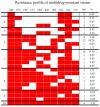Association between Phenotypes of Antimicrobial Resistance, ESBL Resistance Genes, and Virulence Genes of Salmonella Isolated from Chickens in Sichuan, China
- PMID: 37685034
- PMCID: PMC10486400
- DOI: 10.3390/ani13172770
Association between Phenotypes of Antimicrobial Resistance, ESBL Resistance Genes, and Virulence Genes of Salmonella Isolated from Chickens in Sichuan, China
Abstract
The aim of this study was to explore the association between antimicrobial resistance, ESBL genes, and virulence genes of Salmonella isolates. From 2019 to 2021, a total of 117 Salmonella isolates were obtained from symptomatic chickens in Sichuan Province, China. The strains were tested for antimicrobial resistance and the presence of ESBL according to the Clinical and Laboratory Standards Institute (CLSI) instructions. The presence of ESBL genes and genes for virulence was determined using Polymerase Chain Reaction (PCR). In addition, Multilocus Sequence Typing (MLST) was applied to confirm the molecular genotyping. Moreover, the mechanism of ESBL and virulence gene transfer and the relationships between the resistance phenotype, ESBL genes, and virulence genes were explored. The isolates exhibited different frequencies of resistance to antibiotics (resistance rates ranged from 21.37% to 97.44%), whereas 68.38% and 41.03% of isolates were multi-drug resistance (MDR) and ESBL-producers, respectively. In the PCR analysis, blaCTX-M was the most prevalent ESBL genotype (73.42%, 58/79), and blaCTX-M-55 showed the most significant effect on the resistance to cephalosporins as tested by logistic regression analysis. Isolates showed a high carriage rate of invA, avrA, sopB, sopE, ssaQ, spvR, spvB, spvC, stn, and bcfC (ranged from 51.28% to 100%). MLST analysis revealed that the 117 isolates were divided into 11 types, mainly ST92, ST11, and ST3717. Of 48 ESBL-producers, 21 transconjugants were successfully obtained by conjugation. Furthermore, ESBL and spv virulence genes were obtained simultaneously in 15 transconjugants. These results highlighted that Salmonella isolates were common carriers of ESBLs and multiple virulence genes. Horizontal transfer played a key role in disseminating antimicrobial resistance and pathogenesis. Therefore, it is necessary to continuously monitor the use of antimicrobials and the prevalence of AMR and virulence in Salmonella from food animals and to improve the antibiotic stewardship for salmonellosis.
Keywords: ESBL genes; MLST; Salmonella; antimicrobial resistance; chicken; virulence genes.
Conflict of interest statement
The authors have no conflict of interest to declare.
Figures






References
-
- Ma Y., Xu X., Gao Y., Zhan Z., Xu C., Qu X., Chen Z., Bai J., Liao M., Zhang J. Antimicrobial resistance and molecular characterization of Salmonella enterica serovar Corvallis isolated from human patients and animal source foods in China. Int. J. Food Microbiol. 2020;335:108859. doi: 10.1016/j.ijfoodmicro.2020.108859. - DOI - PubMed
-
- Wang J., Zhu X., Zhao Y., Liu H., Zhang Z., Yan L., Chen Y., Robertson I.D., Guo A., Aleri J.W. Prevalence and antimicrobial resistance of Salmonella and ESBL E. coli isolated from dairy cattle in Henan Province, China. Prev. Vet. Med. 2023;213:105856. doi: 10.1016/j.prevetmed.2023.105856. - DOI - PubMed
Grants and funding
LinkOut - more resources
Full Text Sources

